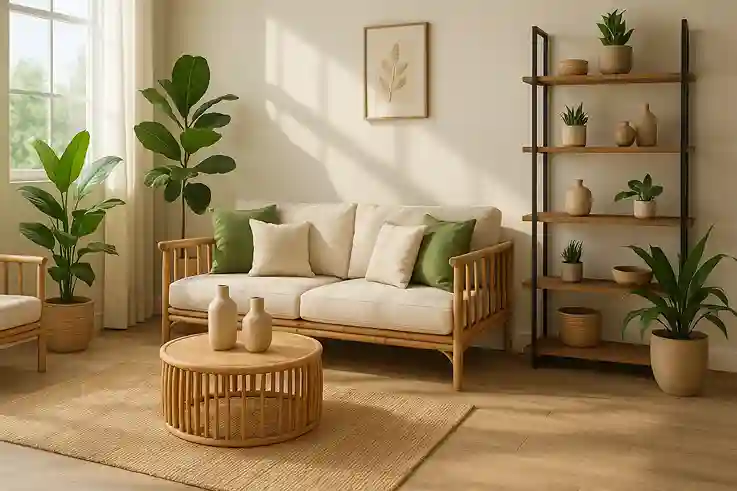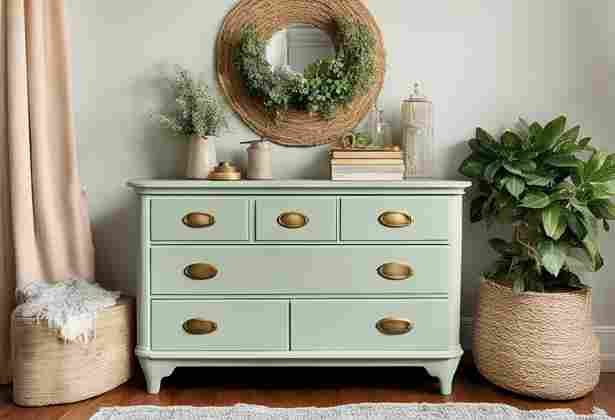Sustainable Home Decor is more than a buzzword. It’s about creating a home that blends beauty, health, and eco-conscious living. Imagine walking into your living room. The air feels fresh, free from toxins. Sunlight bounces off natural wood and soft, organic fabrics. A few leafy plants brighten the corners. Everything feels calm, welcoming, and alive. That’s the promise of decorating sustainably.
This approach goes beyond looks. It’s about choosing furniture, finishes, and accents that are safe for you and kind to the planet. Natural materials bring warmth and character that synthetic options can’t match. Eco-friendly paints and fabrics keep the air cleaner for your family. And because sustainable pieces are often built to last, they save money over time by avoiding frequent replacements.
When you embrace this mindset, your home becomes more than a collection of stylish rooms. It turns into a space that supports well-being, reflects mindful choices, and tells a story of care—for yourself, your loved ones, and the world around you.
What Makes Sustainable Home Decor Different?
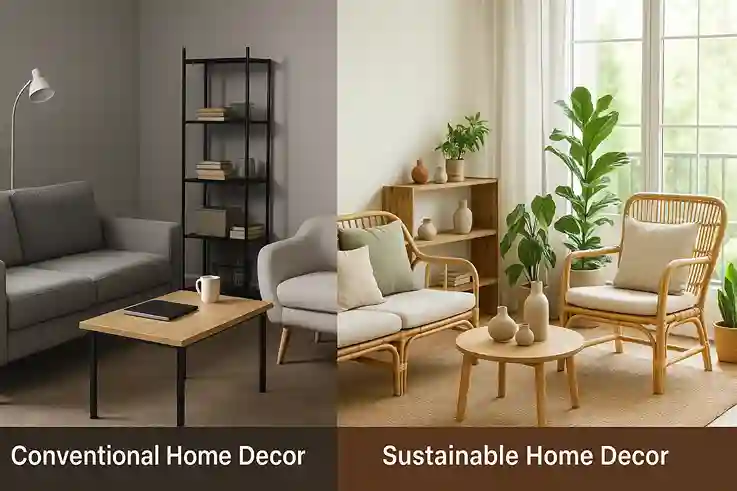
At its core, Sustainable Home Decor means making design choices that care for both people and the planet. It’s not only about how a room looks, but also about the impact your decor has on your health and the environment.
Traditional decor often relies on synthetic fabrics, plastics, and finishes that release harmful chemicals into your air. Mass-produced furniture can be made from cheap materials, treated with toxins, and built for short-term use. These pieces may look appealing at first but often harm indoor air quality and end up in landfills quickly.
Sustainable decor takes the opposite approach. It focuses on eco-friendly and ethical practices, from the materials used to the people who craft them. Think reclaimed wood furniture, non-toxic paints, or rugs woven by artisans using natural fibber’s. These choices don’t just reduce waste—they also create healthier living spaces where you can breathe easier and feel at peace. By choosing sustainable options, you’re not just decorating your home. You’re shaping a lifestyle that values longevity, wellness, and responsibility.
Benefits of Choosing Sustainable Home Decor

Improved Indoor Air Quality
Many conventional paints, glues, and finishes release harmful chemicals known as VOCs. These toxins don’t just disappear after the paint dries—they linger, slowly polluting the air inside your home. Over time, they can cause headaches, allergies, and breathing issues without you even realizing the source.
Choosing non-toxic paints, natural fabrics, and untreated wood changes that story. These safer options keep harmful chemicals out of your space. The difference is noticeable—your rooms feel fresher, and the air is easier to breathe. You create a healthier home where your family can relax without hidden risks.
Reduced Environmental Footprint
Sustainable Home Decor goes beyond looks—it reduces waste and conserves precious resources. Every time you choose reclaimed wood, recycled metal, or organic textiles, you lower the demand for new raw materials. Instead of cutting down another tree or producing more plastic, you give new life to what already exists.
These eco-friendly choices save energy, protect forests, and cut emissions that harm the planet. Even small decisions, like buying a recycled glass vase or a jute rug, create ripple effects. Decorating your home becomes more than style—it becomes a daily step toward protecting the Earth for future generations.
Long-Lasting, Durable Design Choices
Fast furniture often looks good at first glance, but it rarely lasts. A glossy table made of particle board may start to chip after a year. A trendy chair might wobble or wear out before you’ve even finished paying for it. These short-lived pieces create frustration, waste, and the need to buy replacements again and again.
Sustainable Home Decor flips that pattern. Durable pieces are built with quality in mind. Solid wood tables, sturdy fabrics, and timeless designs grow more beautiful as the years pass. Instead of breaking down, they age gracefully, adding character to your home. And while sustainable furniture may cost more upfront, it pays off over time—you buy less, waste less, and enjoy pieces that truly last.
Emotional Benefits of Mindful Living
Your home is more than four walls—it’s the backdrop for your daily life. The textures, colors, and objects around you quietly shape your mood. A room filled with natural materials, fresh air, and thoughtfully chosen pieces has a calming effect. It feels grounding, like a space that truly supports your well-being.
Sustainable Home Decor encourages you to live with intention. Instead of filling rooms with items that are temporary or disposable, you surround yourself with pieces that carry meaning. A handmade ceramic bowl on the counter, a reclaimed wood table in the dining room, or a fair-trade rug in the living space each tells a story. These items do more than decorate—they connect you with nature, with people, and with values that matter.
When your home reflects mindful choices, it doesn’t just look better. It feels better too—a place where you can rest, recharge, and feel at peace.
Natural Materials That Transform Your Space
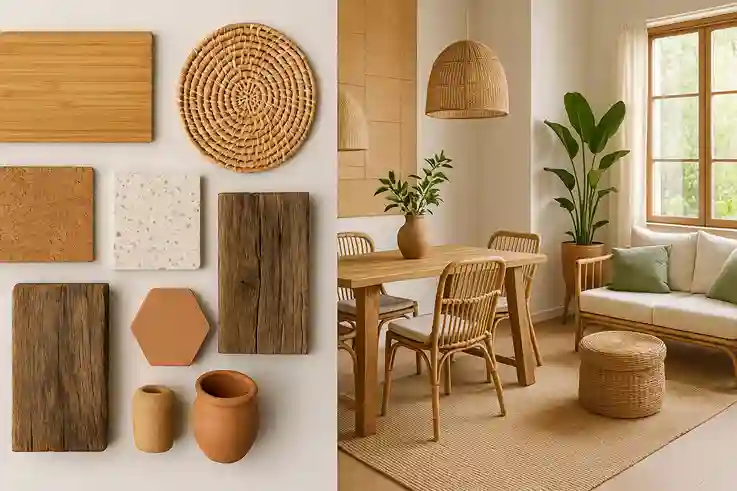
Wood from Certified Sustainable Sources
Wood has a way of instantly grounding a room. Its grains, colors, and textures tell a story that synthetic materials can’t match. By choosing wood from certified sustainable sources, you protect forests while adding timeless beauty to your home. Imagine gathering around a sturdy oak dining table, one that feels solid beneath your hands and will be there for family meals for decades to come. That’s the gift of sustainable wood—it lasts, it warms a room, and it connects you to nature.
Bamboo, Cork, Hemp, Jute, and Rattan
Some materials grow quickly and renew themselves with little impact on the earth. Bamboo, cork, hemp, jute, and rattan are some of the best. Bamboo flooring offers a sleek, modern look, while cork feels soft and warm under your feet. Hemp and jute rugs bring earthy textures that ground a room, and rattan chairs create a light, airy atmosphere. Picture yourself sinking into a rattan armchair with a book, or walking barefoot on a jute rug that feels natural and grounding—that’s how these materials transform daily life.
Stone, Clay, and Reclaimed Metal
Stone, clay, and reclaimed metal add rustic strength and character. A clay vase on a wooden table feels simple yet artistic. Stone countertops in a kitchen stay cool to the touch and will outlast trends. Reclaimed metal light fixtures add an industrial edge while reusing what already exists. Each piece carries history and durability, reminding you that sustainability can be both practical and beautiful.
Bringing these natural elements into your space doesn’t just change the way it looks—it changes the way it feels. The textures invite touch, the surfaces age gracefully, and every detail connects you back to the earth.
Energy-Efficient Lighting and Appliances
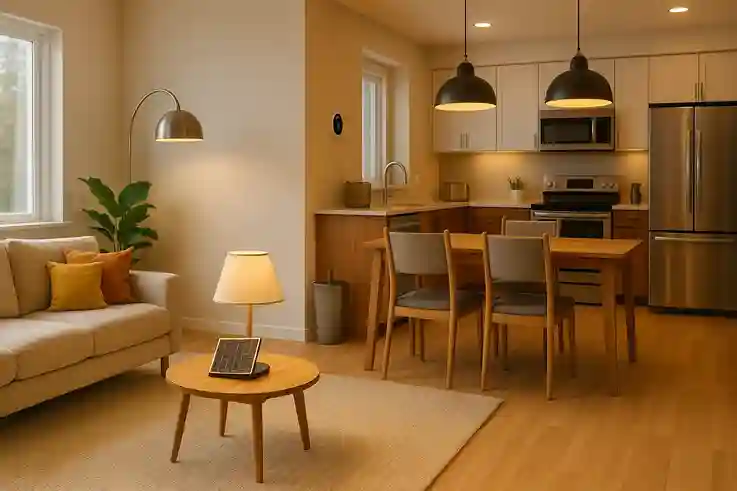
LED Lighting and Smart Bulbs
Lighting sets the mood of every room, and switching to energy-efficient options makes a big difference. LED bulbs use far less power than traditional bulbs and last much longer, reducing waste. Smart bulbs go even further—you can dim them, change colors, or schedule them to turn on before you get home. Imagine walking into a softly lit living room that welcomes you after a long day, all while saving energy and money.
Energy-Saving Decor Elements like Automated Blinds
Windows are often the biggest energy drains in a home. Automated blinds help regulate light and temperature naturally. On hot afternoons, they lower automatically to keep rooms cool. On chilly mornings, they open wide to let in warmth. They’re functional, stylish, and they blend seamlessly with decor. It’s a simple upgrade that makes your home feel modern while cutting energy use.
Stylish, Eco-Friendly Appliances that Blend with Interiors
Appliances are no longer just functional—they’re part of your home’s design. Today, eco-friendly models come in sleek finishes and modern styles that fit beautifully into kitchens and living spaces. From energy-saving refrigerators to efficient washing machines, these appliances reduce power and water use without sacrificing performance. Picture a stainless steel fridge that keeps food fresh while quietly lowering your bills—that’s the beauty of blending sustainability with style.
When you combine efficient lighting, smart window treatments, and eco-friendly appliances, your home becomes both practical and inspiring. These choices prove that saving energy doesn’t mean giving up comfort—it actually enhances it.
Reclaimed and Upcycled Furnishings
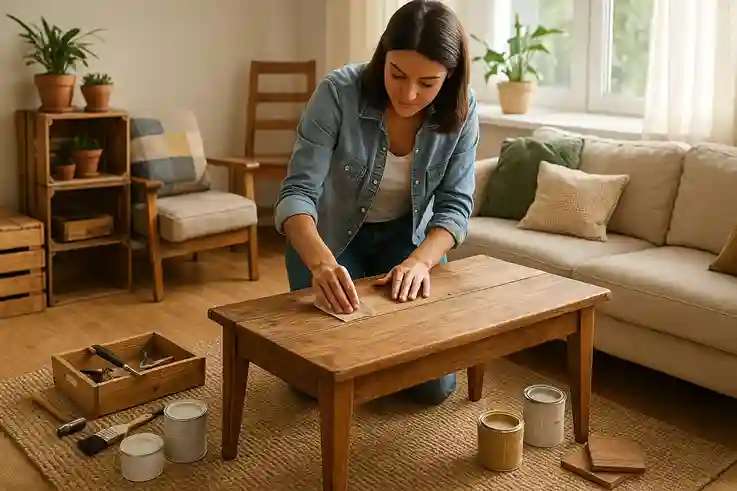
Furniture Made from Salvaged Wood
Every piece of salvaged wood holds a story. The knots, the lines, the weathered edges—all whisper of the life it once lived. A dining table crafted from an old barn beam doesn’t just offer a sturdy surface; it carries decades of character in every grain. You’re not only saving material from waste—you’re giving it a new chapter in your home. That table becomes more than furniture. It’s a gathering place for family meals, conversations, and laughter. It’s sustainable, yes, but it’s also deeply personal. Each scratch or mark adds to its charm, reminding you that your decor has history, soul, and meaning.
Repurposed Antiques and Second-hand Finds
Secondhand never means second best. In fact, antiques and thrifted furniture often carry more strength and character than brand-new, mass-produced pieces. These items were built in an era when quality mattered, which is why they often outlast modern furniture made for quick turnover.
Picture a vintage armchair, its frame still sturdy after decades, reupholstered in organic fabric that feels fresh and soft. Suddenly, it becomes the star of your living room—a blend of history and modern comfort. Or imagine finding an old dresser at a flea market. With a little sanding and polish, it transforms into a one-of-a-kind statement piece, something no showroom could ever replicate.
These second-hand treasures bring charm and individuality to your space. They hold stories of the past while adding new memories in the present. Brand-new furniture may be flawless, but second-hand pieces are soulful—and that’s a beauty you can’t mass-produce.
DIY Upcycling Projects for a Personal Touch
Sometimes, all it takes is a little creativity. Painting an old bookshelf in a fresh, non-toxic color, turning mason jars into hanging lights, or transforming a wooden pallet into a rustic coffee table—all of these projects add personality while reducing waste. Each upcycled piece becomes a reflection of your style and effort, reminding you that beauty can come from reimagining what you already have.
Reclaimed and upcycled furnishings do more than save resources. They make your home unique, filled with items that tell stories instead of blending into trends. When you choose them, you choose character, sustainability, and creativity all at once.
Non-Toxic Paints and Finishes
Why VOC-Free Paints Matter
Freshly painted walls may look stylish, but the “new paint smell” often signals hidden toxins. Many paints release VOCs—volatile organic compounds—that linger in your home’s air. Over time, they can cause headaches, allergies, and respiratory issues. By choosing VOC-free options as part of your Sustainable Home Decor, you improve indoor air quality and create a safer, healthier living space.
Natural Alternatives: Limewash, Clay-Based Paints, Beeswax Finishes
Sustainable Home Decor embraces natural materials, and paints and finishes are no exception. Limewash brings soft texture and timeless character. Clay-based paints add depth while keeping walls breathable. Beeswax and natural oils protect wood, highlight its natural grain, and keep toxins away. These alternatives not only look beautiful but also support a healthier home.
How They Enhance Both Air Quality and Beauty
Choosing non-toxic finishes blends wellness with style. A limewashed wall glows softly in the afternoon sun. Clay-based tones bring earthy warmth to any room. A beeswax-polished table feels smooth, natural, and inviting to touch. With every finish, Sustainable Home Decor proves that design can be both eco-friendly and elegant—improving air quality while enhancing beauty.
Indoor Plants for Health and Beauty
Plants That Purify Air Naturally
Some of the best additions to Sustainable Home Decor don’t require building materials at all—they come in pots. Plants like peace lilies, snake plants, and pothos are natural air purifiers. They filter toxins while releasing fresh oxygen, making your home healthier without chemicals or machines. A corner filled with greenery doesn’t just look good—it helps you breathe better too.
Low-Maintenance Greenery for Modern Homes
Not everyone has a green thumb, and that’s okay. Low-maintenance plants like succulents, ZZ plants, or spider plants thrive with little attention. They’re perfect for modern, busy lifestyles, adding beauty without stress. Even a single potted plant on a windowsill can brighten the space and connect you to nature daily.
Blending Nature with Decor for Stress Relief
Plants bring more than oxygen—they bring calm. Studies show that simply being around greenery reduces stress and improves focus. Adding plants to your decor softens harsh lines and introduces natural textures. A living room with trailing vines or a bedroom with a leafy corner instantly feels more restful. With plants, Sustainable Home Decor creates spaces that support both beauty and well-being.
Top 10 Indoor Plants for Sustainable Home Decor
| Plant | Care Tips | Best Room |
|---|---|---|
| Snake Plant | Thrives on neglect, needs little water, tolerates low light. | Bedroom or Living Room |
| Peace Lily | Keep soil moist, enjoys indirect light, wipe leaves regularly. | Bedroom or Office |
| Pothos | Water when soil dries, grows quickly in low to bright light. | Living Room or Bathroom |
| Spider Plant | Water weekly, grows best in indirect sunlight. | Kitchen or Living Room |
| ZZ Plant | Drought tolerant, prefers low to moderate light. | Office or Bedroom |
| Aloe Vera | Needs bright, indirect light, water sparingly. | Kitchen or Bathroom |
| Areca Palm | Water often, needs bright, indirect light, mist leaves. | Living Room |
| Rubber Plant | Prefers indirect light, water when topsoil dries. | Living Room or Office |
| Succulents | Bright light, little water, ideal for beginners. | Bedroom windowsill or Study |
| Boston Fern | Needs humidity, water often, thrives in indirect light. | Bathroom or Kitchen |
This table highlights ten of the best plants to include in Sustainable Home Decor. Each plant brings its own benefits—some purify the air, others thrive with little care, and all add natural beauty to your home. By matching the right plant to the right room, you can create a healthier, more inviting space while keeping your decor eco-friendly and stress-free.
Supporting Ethical and Local Brands
Importance of Fair-Trade and Handmade Decor
Fair-trade and handmade items add more than style to your home—they add meaning. Choosing a fair-trade rug or handwoven textile supports artisans who are paid fairly for their craft. Handmade decor carries the touch of the maker, with tiny imperfections that make each piece unique. Within Sustainable Home Decor, these choices remind you that beauty can also be ethical and compassionate.
How Local Artisans Reduce Carbon Footprint
Mass-produced furniture and decor often travel thousands of miles before reaching your home. That journey leaves behind a heavy carbon footprint. Local artisans change that. A ceramic vase bought from a neighbourhood potter or a carved wooden bowl made by a craftsman nearby requires little shipping and minimal packaging. Supporting local makers reduces emissions while investing in your own community. It’s sustainability that feels both practical and personal.
Making Decor Choices That Tell a Story
Every handmade or locally crafted item has a story—the hands that shaped it, the traditions behind it, and the values it represents. Imagine buying a handwoven rug from a weekend market. The artisan shares how the dye comes from plants grown in her village and how each pattern carries cultural meaning. That rug isn’t just another floor covering; it’s a piece of history, a story woven into your home. This is the power of Sustainable Home Decor—your space becomes more than stylish, it becomes soulful, filled with items that carry authenticity and connection.
FAQs On Sustainable Home Decor
Conclusion On Sustainable Home Decor
Sustainable Home Decor is more than a design choice—it’s a commitment to living in harmony with your health, your home, and the planet. By embracing natural materials, non-toxic finishes, energy-efficient upgrades, and meaningful handmade pieces, you create a space that feels beautiful and safe at the same time. The best part? Sustainable choices don’t have to be overwhelming. Even small changes—like adding a few indoor plants, choosing fair-trade textiles, or repainting with VOC-free colors—make a real difference. Over time, these little steps transform your home into a sanctuary that reflects your values while reducing your environmental footprint.
A sustainable home isn’t just about how it looks—it’s about how it feels. It feels calmer, fresher, and more connected to the world around you. And that is the true beauty of decorating mindfully.
So, tell me—which sustainable swap would you start with in your own home?
Share your ideas and inspire others to begin their journey toward a healthier, more eco-friendly living space.

Amber Hexshot is a creative blogger with a specialty in home décor, where she shares fresh ideas on design, styling, and creating inviting spaces. With a keen eye for detail and a love for transforming everyday rooms into inspiring environments, she enjoys helping readers bring beauty and personality into their homes. Beyond décor, Amber also explores other topics such as lifestyle, travel, and personal growth, offering a wide variety of content that resonates with her audience.
When she’s not writing, Amber loves visiting art galleries, experimenting with DIY projects, and discovering unique design trends from around the world. Her approachable tone and practical advice make her blogs both inspiring and easy to follow.
